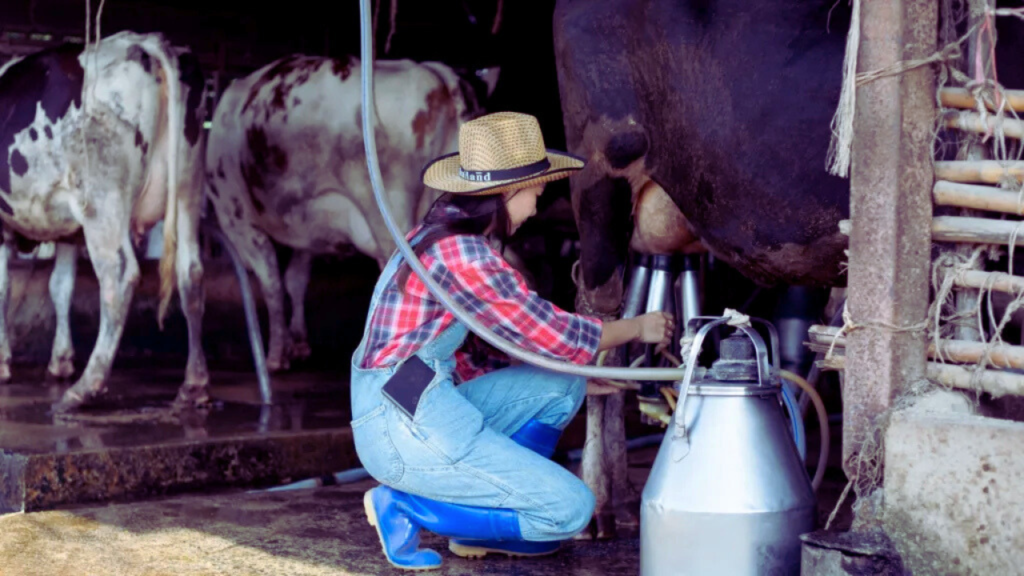Dairy farming is a time-tested and profitable business that continues to thrive due to the ever-growing demand for dairy products such as milk, cheese, and butter. As the global population increases, more consumers are turning to locally produced and nutritious dairy options, making the dairy industry a promising field for new entrepreneurs. However, starting a dairy farm requires careful planning, resources, and a deep understanding of the agricultural process. It’s essential to make smart choices from the beginning, like selecting the right breed of cows, understanding local regulations, and ensuring the farm has the necessary infrastructure for sustainability.
Success in dairy farming goes beyond merely purchasing livestock. A thriving dairy farm depends on maintaining the health of the herd, ensuring access to proper nutrition, and providing a clean and comfortable environment. Additionally, effective management practices, from milking to distribution, play a significant role in long-term success. A well-run dairy farm requires substantial investment in both time and capital, but with the right strategy, dedication, and management skills, it can lead to a rewarding and profitable venture that meets the demands of an ever-growing market.
Understanding Dairy Farming
Dairy farming is the practice of breeding and raising cows or other dairy animals to produce milk, which can be processed into various products like butter, cheese, yogurt, and ice cream. It is a crucial part of the agricultural industry and plays a significant role in food production worldwide. Dairy farming can range from small, family-owned farms to large commercial operations, depending on the scale of production. At its core, dairy farming involves proper herd management, regular milking, and ensuring that animals receive the necessary care and nutrition for high-quality milk production.
Dairy farmers must choose the right breed of cows that are suited to their farm’s environment and production goals. Common breeds include Holstein, Jersey, and Guernsey, each with distinct characteristics in terms of milk yield, fat content, and temperament. Apart from breeding, dairy farmers must also manage the health of the herd by ensuring access to clean water, adequate food, and regular veterinary care to prevent disease outbreaks. A healthy cow produces high-quality milk, which is vital for a profitable dairy farm.
Another critical aspect of dairy farming is maintaining proper milking routines. Milking machines are typically used to extract milk from cows hygienically and efficiently. The milk is then stored in refrigerated tanks to preserve its freshness. Dairy farmers must also navigate the logistical side of the business, including processing, packaging, and distributing the milk or other dairy products to the market. With the right techniques and careful management, dairy farming can be a sustainable and profitable venture that provides essential nutrition to communities around the world.
What is Dairy Farming?
Dairy farming is the practice of breeding and raising animals, typically cows, for the production of milk. It is a vital sector in agriculture, responsible for providing dairy products such as milk, cheese, yogurt, and butter, which are essential to the global food supply. Dairy farming involves both livestock management and milk production, requiring farmers to maintain healthy herds and establish efficient milking systems. Farmers often choose breeds like Holstein or Jersey, which are known for their high milk yield and adaptability to various environments.
Essential Elements of Dairy Farming
Successful dairy farming relies on several key components: good herd management, optimal feeding, health care, and efficient milking techniques. Maintaining a well-balanced diet for the cows is essential for maximizing milk production. Veterinary care is equally important to prevent disease outbreaks and ensure the cows are in optimal condition. Milking must be done regularly and hygienically to produce high-quality milk. Dairy farming also involves handling waste and ensuring the cleanliness of the environment, as these factors can directly impact the quality of the milk.
Choosing the Right Breed of Cow
The breed of cows selected plays a critical role in the success of a dairy farm. Different breeds produce varying amounts of milk and have distinct characteristics. For example, Holstein cows are known for their high milk yield, while Jersey cows produce milk with a higher fat content, making it ideal for cheese production. The choice of breed should align with the farm’s goals and market demands. Breeding strategies and genetic selection are often used to enhance milk production and overall herd health over time.
Dairy Farming Techniques and Equipment
Dairy farming requires specialized equipment, such as milking machines, feed systems, and refrigeration tanks. Milking machines are typically used to extract milk from the cows efficiently and hygienically, while automated feed systems ensure that cows receive the correct amount of nutrition. Refrigeration tanks are used to store the milk at the correct temperature to maintain freshness and prevent spoilage. Investment in the right equipment is crucial to maximizing efficiency and profitability in dairy farming.
Health Management and Veterinary Care

A successful dairy farm depends on the health and well-being of the cows. This includes routine veterinary care, vaccinations, and regular health check-ups to prevent and treat diseases. Disease management is a top priority, as outbreaks can lead to a significant loss of production and revenue. Dairy farmers must also ensure that their cows are free from parasites and other health issues that can affect milk production. A healthy cow produces high-quality milk, which is key to the profitability of the dairy farm.
Milking Process and Milk Storage
The milking process must be performed at regular intervals, typically two to three times a day, to ensure optimal milk yield. Milking machines are used to extract milk from the cows, which is then stored in refrigerated tanks to maintain its freshness and prevent bacterial growth. The entire milking process must be hygienic to avoid contamination, and proper cleaning of equipment is essential. Farmers need to adhere to strict guidelines and regulations to ensure the milk they produce meets quality standards.
Challenges in Dairy Farming
Dairy farming faces several challenges, including fluctuating market prices for milk, increasing feed costs, and the environmental impact of large-scale operations. Farmers must be able to manage costs, such as feed, labor, and equipment, while also dealing with the volatility of the dairy market. Climate change is also affecting dairy farming, as it can impact feed quality and animal health. Additionally, farmers must address concerns about animal welfare and meet environmental sustainability goals to maintain long-term success.
Economic Potential and Profitability of Dairy Farming
Dairy farming can be a highly profitable venture when managed properly. The demand for dairy products continues to rise globally, providing ample opportunities for dairy farmers. However, profitability depends on several factors, including the size of the operation, milk production efficiency, and access to markets. Large commercial dairy farms often have higher production volumes and can take advantage of economies of scale, while smaller operations may focus on niche markets or premium products. With proper planning, efficient management, and sustainable practices, dairy farming can offer long-term success and profitability.
Key Considerations Before Starting a Dairy Farm
| Consideration | Explanation |
| Initial Capital | Starting a dairy farm requires a significant upfront investment. Consider the cost of land, equipment, livestock, and infrastructure. |
| Land and Space | A dairy farm requires sufficient space for cows to graze. Ensure you have enough land to meet the needs of your herd size. |
| Labor and Workforce | Consider how much labor you will need for milking, feeding, cleaning, and maintaining the farm. Determine whether you will hire employees or work with family members. |
| Milking Equipment | Invest in high-quality milking machines that will help in efficient milk extraction. Consider automation if the scale of the farm justifies it. |
| Veterinary Care | Hiring a qualified veterinarian and ensuring access to emergency care is vital for maintaining the health of your cows and preventing losses. |
Creating a Business Plan for Your Dairy Farm
Creating a solid business plan for your dairy farm is crucial to its success. The plan serves as a blueprint for the operation, guiding decisions, securing funding, and outlining strategies for growth. Start by defining the farm’s goals, such as the desired milk production volume and the type of dairy products you want to produce. The plan should also include detailed financial projections covering initial investments, ongoing operational costs, and expected revenue. By setting clear objectives and strategies, you ensure that your dairy farm is aligned with market needs and opportunities.
The business plan should also address key aspects such as market research to understand customer demand and competition in your area, as well as an operational plan that includes herd management, milking schedules, and staffing needs. It’s essential to include risk management strategies to mitigate potential issues, such as fluctuating milk prices or disease outbreaks. With a thorough business plan, you’ll be well-positioned to navigate the challenges of dairy farming while maximizing your farm’s profitability and sustainability.
Executive Summary
The executive summary is a concise overview of your entire dairy farm business plan, outlining the farm’s primary objectives, long-term goals, and key strategies for success. This section should describe the farm’s vision, mission, and the types of dairy products you plan to produce (e.g., milk, cheese, yogurt). Additionally, mention your target market, competitive advantages, and how you intend to achieve profitability and sustainability. The executive summary serves as a roadmap for the business and should provide enough information to capture the interest of potential investors or stakeholders.
Market Research
Conducting thorough market research is crucial to understanding the demand for dairy products in your area. Start by analyzing local consumption patterns, preferences for dairy products, and potential market size. Identify your competitors—other dairy farms or dairy product suppliers in the region—and assess their strengths and weaknesses. What differentiates your dairy farm? It could be product quality, sustainability practices, or niche offerings (e.g., organic milk). Understanding the local market will help you develop strategies to capitalize on opportunities and mitigate potential challenges.
Financial Projections
In this section, outline your estimated startup costs, including land, equipment, livestock, feed, and labor. Define short-term and long-term financial goals, ensuring to include both fixed and variable costs. Project your expected revenue based on realistic milk yields, product pricing, and market demand. Calculate profitability margins and establish cash flow forecasts to evaluate how long it will take for your farm to break even and become profitable. Financial projections also help in securing loans or investments, as they provide a detailed picture of your farm’s economic viability.
Operational Plan
The operational plan details the day-to-day activities required to run your dairy farm smoothly. This includes outlining milking schedules, herd management practices, feed and nutrition plans, and regular maintenance of the farm facilities. It’s essential to define staffing needs—how many employees you’ll require for milking, animal care, feeding, and processing. Additionally, discuss the production workflow, including storage, processing, and distribution. A well-organized operational plan ensures efficient use of resources and helps maximize productivity.
Risk Management Plan
Dairy farming comes with inherent risks, such as disease outbreaks, fluctuations in milk prices, and supply chain disruptions. It’s essential to have a comprehensive risk management plan to mitigate these uncertainties. This plan should include strategies for disease prevention and control, such as vaccination schedules and biosecurity measures, as well as ways to deal with feed shortages or adverse weather conditions. Additionally, address how you’ll navigate market risks, including price volatility, by potentially diversifying your product line or securing long-term contracts with customers. Being prepared for risks helps ensure the farm’s long-term sustainability and reduces vulnerabilities.
Choosing the Right Equipment for Your Dairy Farm
- Milking Machines: Milking machines are essential for efficient milking. Automatic milking systems (AMS) are an investment for larger farms and allow cows to be milked without human involvement.
- Feed Mixers and Storage: Proper feeding equipment helps maintain the nutritional balance of your herd. Ensure adequate storage for hay, silage, and other feed items.
- Manure Management Systems: Dairy farms produce a lot of manure, and a manure management system is necessary to handle waste efficiently and keep the farm clean.
- Cooling Systems: Milk needs to be cooled immediately after extraction to maintain its quality. Invest in refrigeration systems that can store large quantities of milk.
- Water Supply Systems: Clean, fresh water is essential for dairy cattle. Ensure an adequate and consistent water supply system is in place.
Managing Dairy Cattle and Production
Effective herd management is essential for maximizing the productivity and health of your dairy cattle. A well-managed herd will produce high-quality milk consistently. Key factors to consider include proper nutrition, which ensures cows have the necessary energy and nutrients for milk production. Additionally, regular veterinary care, including vaccinations and disease prevention, is vital for maintaining a healthy herd. Breeding strategies are also important, as selecting the right genetics can improve milk yields and overall herd health. Furthermore, creating a stress-free environment, with comfortable housing and adequate space, contributes to a more productive herd and better-quality milk.
| Factor | Explanation |
| Breed Selection | The breed of cows you choose affects milk yield. Popular dairy breeds like Holsteins and Jerseys are known for their high milk production and good temperament. |
| Feeding | Provide your cows with a balanced diet consisting of quality forage, grains, and necessary supplements. Proper nutrition impacts milk production. |
| Health Management | Regular veterinary care, vaccinations, and parasite control are essential for maintaining a healthy herd. Cows should be checked for signs of illness regularly. |
| Breeding Program | Develop a breeding program to ensure the health of your cows and increase your herd size. Controlled breeding will help you maximize milk production. |
| Milking Routine | A consistent milking schedule ensures that cows are not stressed and can maintain high milk output. Hygiene and proper technique are also important. |
Marketing Your Dairy Products
Marketing your dairy products is essential to the success of your dairy farm business. Once you have established a reliable production process, reaching out to potential customers through effective marketing strategies will help you stand out in a competitive market. Begin by creating a solid brand identity, which includes a memorable logo, consistent messaging, and attractive packaging that highlights the quality and source of your products. A strong brand image will not only attract customers but also foster loyalty and trust.
Local markets are a great starting point for marketing your dairy products. Farmers’ markets, local grocery stores, and community events allow you to directly connect with customers and build a loyal base. Additionally, establishing an online presence through a website and social media platforms will give you wider visibility. Transparency about your farming practices, such as sustainable or organic methods, can resonate with consumers who value knowing where their food comes from. You can also diversify your product line by offering value-added items like cheese, yogurt, and butter, which can significantly increase your farm’s revenue.
- Build a Strong Brand Identity: Create a unique brand that communicates the quality of your products. This includes designing a memorable logo, attractive packaging, and clear messaging about the benefits and source of your dairy products. A strong brand helps differentiate your farm from competitors.
- Sell Locally: Begin by selling your dairy products at local farmers’ markets, grocery stores, or through direct-to-consumer channels like a farm stand. Building a loyal customer base locally will give your brand credibility and help establish a foundation for growth.
- Develop an Online Presence: In today’s digital world, having a website and active social media profiles is crucial. Engage with customers on platforms like Instagram, Facebook, and Twitter to share updates, behind-the-scenes insights, and promotions. Being transparent about your farming practices will create trust with consumers.
- Leverage Word-of-mouth Marketing: Encourage satisfied customers to spread the word about your dairy products. Positive reviews, testimonials, and word-of-mouth recommendations can be powerful tools to attract new buyers. Offering incentives like referral discounts can also boost this strategy.
- Offer Value-Added Products: Diversifying your product offerings with items like cheese, yogurt, butter, or cream can significantly boost your income. Value-added products attract a wider range of customers and give your dairy farm a competitive edge in the marketplace.
- Partner with Local Businesses: Collaborate with local cafes, restaurants, and shops to get your products on their menus or shelves. Partnerships with local businesses help increase exposure while supporting other local enterprises and creating a sense of community.
Common Challenges in Dairy Farming
Dairy farming presents several challenges that can impact the profitability and sustainability of the business. One of the primary concerns is the rising cost of feed, which fluctuates based on factors such as weather conditions, crop yields, and market prices. These price increases can significantly strain a farm’s budget, requiring farmers to diversify their feed sources or explore more cost-effective options. Additionally, animal diseases like mastitis and Bovine Tuberculosis can negatively affect milk production and increase veterinary costs. Maintaining herd health through regular veterinary visits and proper hygiene is crucial to minimize these risks.
Another challenge is market fluctuations, as the prices of dairy products can change rapidly due to shifts in consumer demand, trade policies, or global competition. These fluctuations make it difficult to predict and maintain stable revenue. Furthermore, labor shortages in dairy farming can make it hard to find skilled workers, especially during busy seasons. The increasing complexity of regulations surrounding animal welfare, environmental concerns, and milk quality adds additional pressure. Dairy farmers must stay informed on regulatory changes and invest in technologies or strategies to stay competitive in a constantly evolving market.
Rising Feed Costs
The cost of feed can fluctuate significantly due to a variety of factors, such as droughts, economic instability, and global commodity price changes. Feed accounts for a large portion of dairy farming expenses, so when prices rise unexpectedly, it can greatly impact your profitability. To combat this, farmers often seek ways to diversify their feed sources, including growing their crops or negotiating better prices with suppliers. Additionally, farmers can implement feed management strategies to optimize feed usage and reduce waste.
Animal Diseases
Dairy cattle are susceptible to a variety of diseases, including mastitis, which affects milk production, and Bovine Tuberculosis, which can lead to the culling of infected animals. These diseases can lead to higher veterinary costs, decreased milk yield, and even reputational damage if the farm’s milk supply is tainted. To mitigate these risks, farmers need to establish regular health protocols, invest in preventative measures, maintain good sanitation practices, and schedule consistent veterinary check-ups to ensure herd health and reduce the risk of disease transmission.
Market Fluctuations
The prices for dairy products can experience significant fluctuations due to shifts in consumer demand, changes in production levels, or broader economic conditions. Factors such as trade tariffs, global competition, and consumer preferences can all influence dairy prices. For dairy farmers, this volatility can make it difficult to predict income and maintain stable profits. A common strategy to protect against market volatility is diversifying product offerings. For example, turning milk into cheese, yogurt, or butter can help farmers reduce reliance on the fluctuating price of raw milk and tap into different consumer markets.
Labor Shortage
Labor shortages in dairy farming can be particularly problematic, especially during high-demand periods such as calving seasons or peak milk production months. Dairy farming requires skilled workers who understand animal health, milking processes, and farm equipment. Finding such workers, especially in rural areas, can be a significant challenge. In response, many farms are exploring automation options, such as milking robots, automatic feeders, and computerized herd management systems, which can help reduce the dependency on human labor and improve operational efficiency.
Regulatory Compliance
Dairy farmers must adhere to a wide range of local, state, and federal regulations governing animal welfare, milk quality, and environmental practices. Compliance with these regulations can involve regular inspections, paperwork, and potentially costly upgrades to facilities. The complexity of these requirements may be overwhelming, particularly for smaller operations with limited resources. Staying updated with regulatory changes and investing in necessary equipment or training programs can help ensure that the farm remains compliant, avoiding potential fines or disruptions to business operations.
Environmental Impact
Dairy farming can have significant environmental impacts, including waste management challenges, water usage, and greenhouse gas emissions. Managing these environmental concerns effectively is not only essential for sustainable operations but can also be required by law in many areas. Implementing practices such as recycling manure for fertilizer, investing in water conservation technologies, and reducing emissions through more efficient farming techniques can help minimize the environmental footprint while ensuring long-term viability for the farm.
Capital Investment
Dairy farming requires substantial upfront capital to purchase land, equipment, and livestock, as well as ongoing investments in facilities, feed, and veterinary care. Securing financing for a dairy farm can be challenging, particularly for new farmers or those without sufficient collateral. Obtaining favorable loans or grants, exploring government subsidies, or partnering with investors are common methods of securing necessary capital. Additionally, it’s crucial to plan for ongoing investment in technology and infrastructure to maintain or improve productivity.
Weather and Climate Changes
Dairy farming is heavily impacted by weather conditions, particularly in regions where extreme weather events like droughts, floods, or harsh winters are common. These weather patterns can affect feed availability, water supply, and the overall health of the cattle. Climate change is exacerbating this challenge, making it harder to predict weather conditions and plan accordingly. Farmers need to stay adaptable by diversifying feed sources, investing in climate-resistant technologies, and utilizing weather forecasts to better plan their operations.
Wrapping Up
Starting and running a successful dairy farm is a complex but rewarding venture that requires careful planning, substantial investment, and diligent management. From choosing the right cattle breed and securing quality feed to managing your operations and adhering to regulations, every decision plays a critical role in your farm’s long-term success. Ensuring that you have the necessary resources, including skilled labor and proper equipment, is essential for smooth day-to-day operations.
Equally important is staying updated on industry trends, market fluctuations, and distribution strategies to effectively meet consumer demand. The dairy farming industry continues to grow, driven by rising consumption of dairy products worldwide. With the right approach, focus on quality production, and commitment to customer satisfaction, dairy farming can become a profitable and sustainable business. Those who enter the market with a solid plan and adaptability will be well-positioned for success in this thriving industry.
FAQs
What is the best breed of cow for dairy farming?
The best breed for dairy farming depends on your farming conditions and goals. Holstein cows are widely known for their high milk yield, making them a top choice for large-scale operations. Jerseys, on the other hand, produce milk with a higher butterfat content, making them ideal for those focusing on premium milk products.
How much money is required to launch a dairy farm?
The capital required to start a dairy farm varies based on factors like farm size and location. Generally, a small to medium-sized dairy farm may need an initial investment ranging from $50,000 to $100,000 to cover costs for land, cattle, equipment, and infrastructure.
How often do cows need to be milked?
Cows typically need to be milked twice a day—once in the morning and once in the evening. Larger farms might use automated milking systems, which help streamline the milking process and increase efficiency.
Which illness affects dairy cows the most frequently?
Mastitis is one of the most common diseases found in dairy cows. It’s an infection in the udder that can lower milk production and quality. Regular veterinary visits, proper milking techniques, and maintaining good hygiene are essential to prevent and manage mastitis.
Can I make additional products from milk?
Absolutely! Dairy farmers can create value-added products like cheese, yogurt, butter, and ice cream from their milk. These products tend to offer higher profit margins compared to selling raw milk and can diversify your income streams.
How do I ensure my dairy farm is sustainable?
To ensure sustainability, implement practices such as rotational grazing, effective waste management, and water conservation. Additionally, using eco-friendly feed and reducing energy consumption can greatly contribute to sustainable dairy farming practices.
What are the advantages of running a dairy farm?
Dairy farming can be highly profitable, providing steady income through regular milk production. It also supports long-term growth, boosts local economies, and offers essential food products to communities. It’s a business that blends profitability with social impact.










